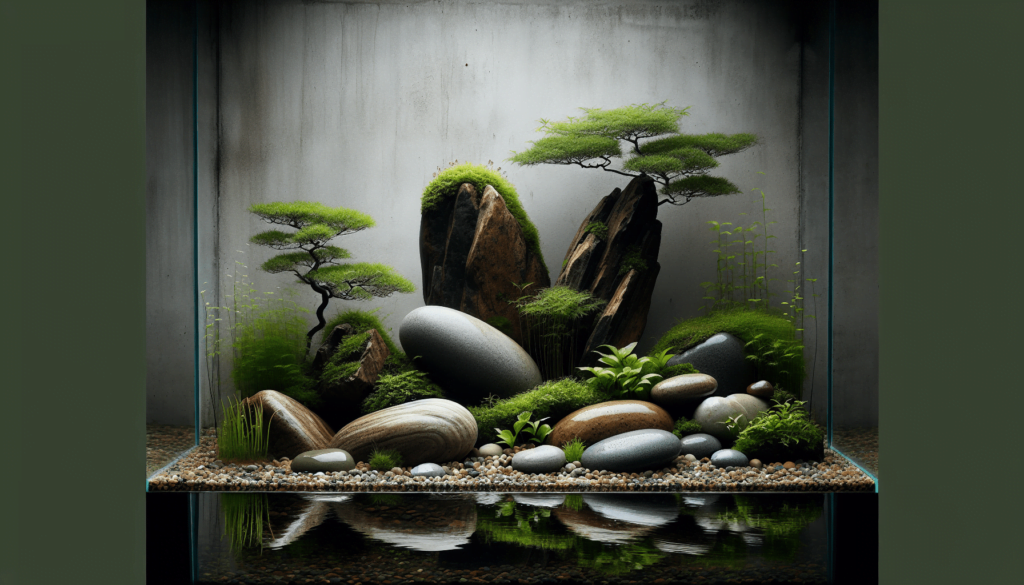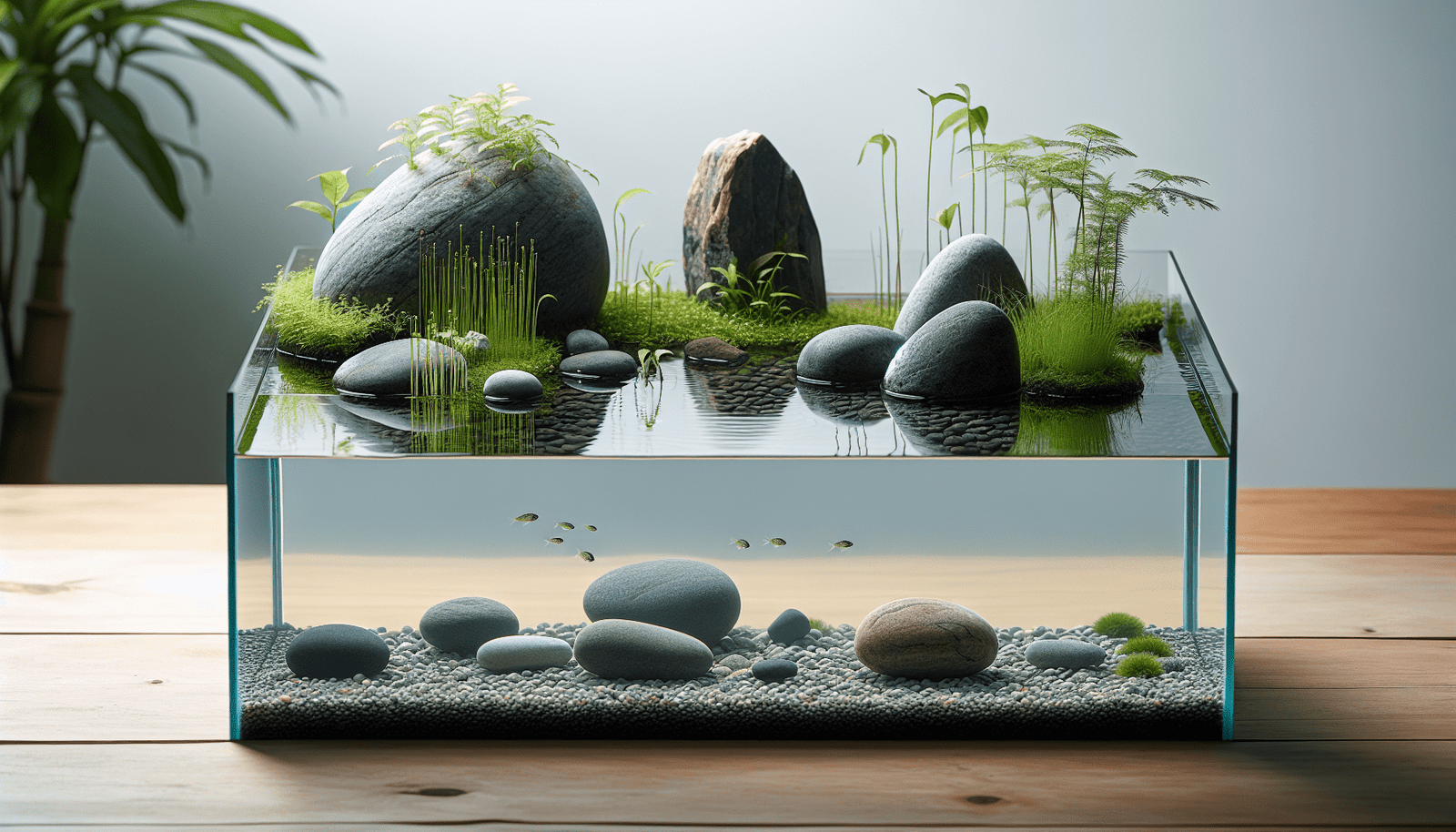Imagine you’re an artist, but instead of paint, you use rocks, plants, and water to create a beautiful picture. That’s what Iwagumi aquascaping is all about! It’s a special way of setting up a fish tank that makes it look like a peaceful part of nature. People have been arranging rocks and plants in water to make beautiful mini landscapes for a long time. Now, it’s becoming even more popular. By learning how the rocks are placed and which plants are best, you can make a fish tank that not only looks pretty but also feels like a little piece of the outdoors right in your home.
Mastering the Art of Iwagumi Aquascaping
Have you ever wondered how to create a peaceful, beautiful underwater scene in your own home? Let’s dive into the amazing world of Iwagumi aquascaping, where you can create your own little aquatic paradise!
What is Iwagumi Aquascaping?
Iwagumi aquascaping is a unique style of arranging plants and rocks in an aquarium to create a natural and simple landscape. It’s like being an artist, but instead of paint, you use rocks, plants, and water!
Overview
This technique is not just about making your tank look nice; it’s about creating harmony and balance in your underwater environment. It connects you with nature right in your living room!
Thesis Statement
Mastering the art of Iwagumi aquascaping enhances not only the beauty of your aquarium but also supports the well-being of the fish and plants living in it.
Historical Context
The word “Iwagumi” is Japanese, where “iwa” means rock, and “gumi” means group. This style was developed in Japan and is inspired by Japanese gardening principles.
Origin of Iwagumi
The concept was popularized by Takashi Amano, a famous aquarist and photographer. He brought the serene beauty of Japanese rock gardens into the aquatic world, emphasizing minimalism and natural beauty.

Current Trends in Iwagumi Aquascaping
Today, Iwagumi aquascaping has fans all over the world. People enjoy the calm and tranquility it brings and the challenge of creating a perfect, balanced underwater landscape.
Popular Aquatic Plants
- Hemianthus callitrichoides: Also known as “Dwarf Baby Tears,” perfect for creating a lush foreground.
- Eleocharis parvula: Known as “Dwarf Hairgrass,” ideal for a natural-looking grassy bed.
Choice of Rocks
The most commonly used rocks are Seiryu, Ryuoh, and Manten stones. They have interesting textures and help create a natural rugged look.
Key Concepts and Definitions
Understanding a few terms will help you get started with your own Iwagumi tank.
Main Stone
The largest and most focal point rock in the setup. It’s often placed off-center for a natural look.
Supporting Stones
These are smaller than the main stone but play a critical role in balancing the visual weight of the layout.
Layout
The arrangement of stones and plants, which is crucial for achieving harmony and balance in your tank.

Detailed Exploration of Setting Up an Iwagumi Tank
Creating an Iwagumi aquascape involves several detailed steps. Let’s break them down!
Choosing the Right Aquarium
Start with a clear glass tank to best display your aquascape. The size is up to you but remember, larger tanks are generally easier to maintain once set up.
Substrate Selection
Use a nutrient-rich substrate to support plant growth. Aquatic plant soil works well as it’s specially formulated for this purpose.
Positioning Your Stones
Position your main stone first. It should be the largest and most impressive. Supporting stones are placed in a way that complements the main stone, usually in odd numbers to maintain natural asymmetry.
Planting
Plant your chosen aquatic plants while the aquarium soil is still dry. Once planting is done, gently fill the tank with water to avoid disturbing the setup.
Examples and Case Studies
Example 1: A Successful Iwagumi Setup
A 20-gallon tank featuring a dramatic Ryuoh stone as the main stone, complemented by smaller Seiryu stones, and planted densely with Dwarf Hairgrass. This setup took about 6 months to fully mature, resulting in a breathtaking, lush green carpet.
Example 2: Common Challenges
Often, beginners struggle with algae due to inadequate lighting and nutrient imbalances. It’s crucial to monitor and adjust your lighting duration and intensity, and consider CO2 supplementation for better plant growth.
Comparison of Different Perspectives
Some aquarists believe that Iwagumi setups are too stark and minimalist, while others appreciate the purity and simplicity. Exploring different styles can help you decide what resonates best with your aesthetic preferences.
Impact Assessment
Benefits
- Enhances the beauty of your living space.
- Provides a serene and tranquil environment.
- Supports the mental well-being of the observer.
Challenges
- Requires patience and meticulous maintenance.
- Balancing the aquatic environment can be tricky for beginners.
Future Directions and Implications
Predictions
As more people embrace minimalism in their lives, the popularity of Iwagumi aquascaping is likely to grow. Advanced technologies in lighting and water filtration will also make these setups more accessible to beginners.
Implications
Iwagumi aquascaping not only affects the aesthetics of home décor but also promotes a deeper connection with nature and an appreciation for simplicity and balance.
Conclusion
Through the art of Iwagumi aquascaping, you can create a striking yet serene miniature landscape in your aquarium. It’s a fulfilling hobby that combines creativity, patience, and a touch of nature.
Final Thought
Imagine sitting by your Iwagumi tank after a long day, watching the gentle sway of plants and the playful dance of fish. Isn’t that a pocket of peace worth creating?
Engagement
If you have an Iwagumi tank, share your experiences and tips in the comments below! Or, if you’re just starting, feel free to ask any questions. Let’s dive into this beautiful hobby together!
Credible Sources
For further reading, consider checking out works by Takashi Amano or visiting websites dedicated to aquascaping. They are treasure troves of useful information and inspirational designs!



